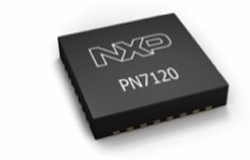A common complaint about Internet-connected thermostats, security cameras, door locks and the raft of other so-called smart home products is that they do not work consistently, if at all. Another is that merely establishing a home network and adding new components to it can be a time-consuming, clunky process. Today, chip maker NXP Semiconductors unveiled its PN7120 chipset, which sports a Near Field Communication (NFC) reader IC and embedded firmware required to support the NFC Forum’s standard interface between an NFC controller and the device’s main application processor.
NFC is a type of passive 13.56 MHz RFID technology that enables wireless data transmissions at short range—4 centimeters (1.6 inches) or less. Olivier Aretz, head of marketing and business development for NXP’s Product Line Infrastructure & Consumer business, says the PN7120 will enable manufacturers of connected home goods to fulfill the promise of plug-and-play products.
NFC devices operate in three modes: reader-writer, in which the NFC module can either collect data from or write data to an NFC RFID tag; peer-to-peer, in which two NFC devices exchange data when in close proximity; and card emulation, in which the only NFC function that the device performs as a proxy for a contactless credit card or a contactless building-access card.
NXP will market the chip to manufacturers of smart-home gateway devices and smart-home products. Its function would largely be to use the peer-to-peer NFC mode to make it easy to pair a device such as a thermostat, light bulb or door lock, with a gateway. “For pairing devices to a gateway, NFC could be used instead of Wi-Fi, BLE [Bluetooth Low Energy] or ZigBee, because while most of those technologies have more bandwidth [needed for other functions, such as sending usage data], the setup of the initial system tends to be complicated. Even BLE, which is meant to be an easy way to pair devices, tends to be complicated,” says Aretz. Pairing would be done by tapping a smart-home product to the gateway device and there would be no need for the user to enter any addition information, such as a password.
Aretz expects that manufacturers will also add the NFC chip to routers, set-top boxes (STBs), audio devices, printers and gaming consoles. In addition to pairing devices with a home network gateway, NFC could also be used for payment functions, such as using an NFC-enabled smartphone to purchase a movie through a set-top box.
In addition, Aretz says, NFC could play a role in industrial IoT applications. A maintenance worker could use a NFC-enabled mobile phone to call up specifications for a specific piece of machinery that needs repair, for example.
The PN7120 is compatible with devices built on the Linux or Android operating systems. Apple has only begun integrating NFC technology into its smartphones starting with the latest model, iPhone 6, and even there the technology has limited functionality. Third-party application developers, therefore, are limited in terms of the applications they can build on the NFC chipset Apple uses.
NFC technology is not new. When asked why NXP was introducing the PN7120 now, Aretz said that the technology has “needed some time to get critical mass,” and that with more than 500 million NFC-enabled smartphones in the marketplace, it has reached volumes large enough to support broader use. But he adds that because NFC is not widely used outside the mobile handset industry, NXP is packaging the PN7120 along with a demo kit that including Raspberry Pi and BeagleBone development boards for prototyping. NXP is offering these tools, plus the embedded firmware, to help smaller companies that might lack large engineering staffs to add NFC functionality to their product offerings quickly. The PN7120 package will be available by July 1 on the NXP website.
NXP may have a steep hill to climb when it comes to pushing NFC into the mix of prominent smart-enabling home technologies, however. Adarsh Krishnan, senior analyst with market research firm ABI Research, notes that “NFC witnessed some traction initially in smart-home devices to make the set-up process easier with peripheral devices, but this is diminishing as vendors face increasing pressure to reduce device costs.” As a secondary wireless-connectivity option, NFC is not a core technology to smart-home products and is therefore seen as an extra cost.
That said, manufacturers who make both appliances and Android-based NFC handsets, such as LG and Samsung, have already added NFC functionality into products such as home door locks and televisions.


